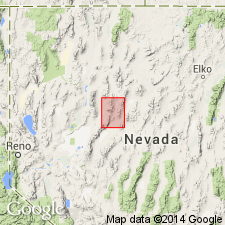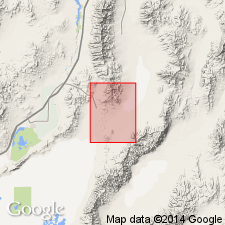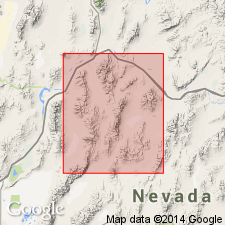
- Usage in publication:
-
- Natchez Pass formation*
- Modifications:
-
- Original reference
- Dominant lithology:
-
- Dolomite
- Limestone
- Volcanics
- AAPG geologic province:
-
- Great Basin province
Summary:
Natchez Pass formation. Light- and dark-colored massive dolomite and limestone in varying proportions. About 200 feet of basic lava flow and volcanic breccia generally present about 400 feet above base. Locally massive dark-brown siliceous conglomerate with some siliceous massive slate about 200 feet below top. Thin lenses of clastic rocks in places. Thickness at type locality 1650 feet; about 1000 feet in Sonoma Range. Conformably overlies Prida Formation (new); underlies Grass Valley Formation. Assigned to Middle and Upper Triassic.
Type locality: Natchez Pass, East Range, Winnemucca quadrangle, north-central NV.
Source: US geologic names lexicon (USGS Bull. 1200, p. 2688-2689).

- Usage in publication:
-
- Natchez Pass formation*
- Modifications:
-
- Revised
- AAPG geologic province:
-
- Great Basin province
Summary:
Natchez Pass formation in Star Peak group. Upper formation in Star Peak group. In Buffalo Mountain quadrangle, comprises lower and upper members. Lower member, predominantly massive gray limestone and dolomite in basal part and altered andesitic volcanic flows, tuff, and breccia, including argillite and siltstone in upper part, is 1000 to 1500 feet thick. Upper member, thin- to thick-bedded impure limestone in basal part and massive gray limestone in upper part, is about 1000 feet thick. Overlies Prida formation; underlies Grass Valley formation. Assigned to Middle and Upper Triassic.
Source: US geologic names lexicon (USGS Bull. 1200, p. 2688-2689).

- Usage in publication:
-
- Natchez Pass Formation*
- Modifications:
-
- Revised
- AAPG geologic province:
-
- Great Basin province
Summary:
The "lower member" of Natchez Pass Formation of Wallace and others (1969) [Geologic map of the Buffalo Mountain quadrangle, Pershing and Church Counties, Nevada: USGS Geologic Quadrangle Map GQ-821, scale 1:62,500] is named Congress Canyon Formation of Star Peak Group in this report. Consists of coarse-grained, allochem-supported limestone interpreted to have been deposited between depositional sites of basinal rocks that form upper member of the Prida Formation and more inner platform rocks included in the Augusta Mountain Formation. Thickness is 120 m (up to 300 m). [See also entry under Congress Canyon.]
Source: Modified from GNU records (USGS DDS-6; Denver GNULEX).
For more information, please contact Nancy Stamm, Geologic Names Committee Secretary.
Asterisk (*) indicates published by U.S. Geological Survey authors.
"No current usage" (†) implies that a name has been abandoned or has fallen into disuse. Former usage and, if known, replacement name given in parentheses ( ).
Slash (/) indicates name conflicts with nomenclatural guidelines (CSN, 1933; ACSN, 1961, 1970; NACSN, 1983, 2005, 2021). May be explained within brackets ([ ]).

